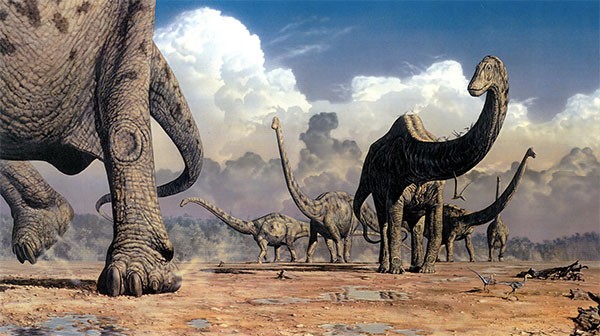
Image: National Geographic

Image: National Geographic
Dinosaurs, among the largest known animals, dominated the world in diverse and wondrous forms for 136 million years. All but their direct descendants, birds, were wiped out by catastrophic climate change caused by a giant meteor impact 66 million years ago, one of five great mass extinctions.
While climate has been changing since Earth’s origin, our burning of fossil fuels is causing what many view as a climate catastrophe, possibly triggering the next mass extinction. Events such as dinosaur evolution and extinction and past climate change provide not only context for the present, but also lessons for our future.
Join Paul E. Olsen, Storke Memorial Professor of Earth Sciences, in a timely discussion on climate change and its past and future impact on planet Earth and its inhabitants.
PRICING
Tickets: $160 for three evenings
($100 for Young Alumni in class years 2008-2017)
DATES & TIMES
Tuesday, January 30
Tuesday, February 13
Tuesday, February 27
6:30 - 8:30 p.m.
*THIS EVENT HAS PASSED. REGISTRATION HAS CLOSED.*
Session 1: Birds are Dinosaurs (Tuesday, January 30)
The discovery of extinct, giant dinosaurs was a triumph of 19th century science, one that quickly got entangled with the theory of evolution by natural selection because they served as the earliest example of a major missing link between two great groups of living animals, reptiles and birds, exactly as predicted by Darwin’s controversial theory. However, science is not linear, and the idea of dinosaurs as bird ancestors fell out of favour in the early 20th century because of nasty accidents of missing and misinterpreted data. A methodological revolution in the late 20th century followed by spectacularly confirming fossil discoveries has shown without a reasonable doubt that birds are living dinosaurs.
Session 2: Mass Extinction (Tuesday, February 13)
A failed hypothesis for measuring the pace of non-avian dinosaur extinction led to the serendipitous discovery of a layer of fallout hypothesized to be from the impact of an extraterrestrial body causing a catastrophic global climate “impact-winter” that lead to one of Earth’s largest mass extinctions 66 million years ago. Ridiculed at the time, the asteroid impact hypothesis spawned successful predictions that ultimately led to the discovery of the buried +250 km diameter Chicxulub crater in Mexico. Four other mass extinctions over the last 600 million years may to be related to global warming and volcanic-winter climate catastrophes caused by planetary-scale volcanic eruptions. A sixth mass extinction caused by Homo sapiens has been underway for the last 60 thousand years and may be accelerating. These mass extinctions seems as important to the history of life as Darwinian adaptation by natural selection
Session 3: Climate: Past, Present, and Future (Tuesday, February 27)
We are in a giant unintended experiment in planetary climate. The burning of fossil fuels is increasing atmospheric levels of CO2, a “greenhouse gas”. Well-understood physics leads to the conclusion that adding CO2 is leading to global warming, for which there is strong evidence in the present and past. How global warming will effect the climate of the future is predicted by mathematical models informed by our understanding past climate change, including CO2-related climate catastrophes that led to mass-extinctions. Frontiers in the study of CO2-forced climate change address whether warming will accelerate the human-caused 6th mass extinction, or will reducing the production of CO2 and putting some of it back in the ground stave off disaster.